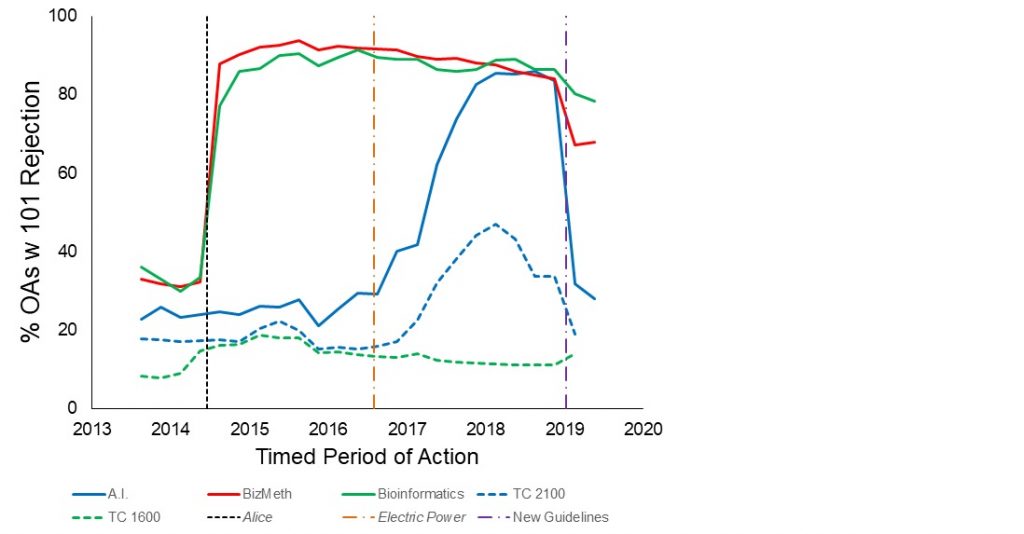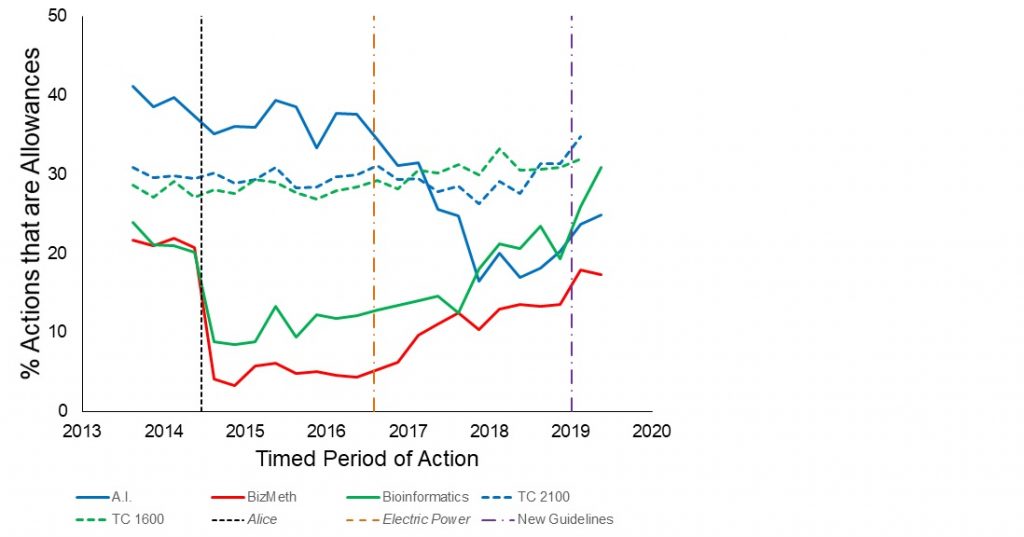“In the six months after the USPTO implemented the 2019 USPTO eligibility guidance, the percentage of applications for which subject matter eligibility rejections were issued dropped across all computer-related art units.”
 The Supreme Court’s 2014 decision in Alice v. CLS Bank made it significantly more difficult to obtain patents for some computer-related technologies. it is, at best, questionable whether court decisions since then have been coherent and consistent. Similarly, marked variation has been observed across art units and across post-Alice time periods as to how examiners are applying Section 101. However, the U.S. Patent and Trademark Office’s (USPTO’s) 2019 Patent Eligibility Guidance added some much-needed clarity and predictability as to how eligibility of computer-related patent applications is being assessed at the agency.
The Supreme Court’s 2014 decision in Alice v. CLS Bank made it significantly more difficult to obtain patents for some computer-related technologies. it is, at best, questionable whether court decisions since then have been coherent and consistent. Similarly, marked variation has been observed across art units and across post-Alice time periods as to how examiners are applying Section 101. However, the U.S. Patent and Trademark Office’s (USPTO’s) 2019 Patent Eligibility Guidance added some much-needed clarity and predictability as to how eligibility of computer-related patent applications is being assessed at the agency.
The 101 Evolution
Alice was decided on the abstract-idea exception to subject matter eligibility. The Supreme Court held that claims related to an electronic escrow service were mere abstract ideas that were ineligible for patent protection. The Court found that mere implementation of an abstract idea on a computer system was insufficient to find the claims patent eligible. The Court set forth a two-part test in which it is determined whether the claims (1) are directed to an abstract idea and if so whether (2) the claims are significantly more than the abstract idea.
Perhaps predictably, Alice’s largest impact was observed in business method art units, where the majority of office actions received eligibility rejections. Applications from other computer-related art units were, at least initially, largely unaffected. This is likely due to the patents at issue in Alice having been examined by business method art units. Yet, as the Federal Circuit held patents from other Technology Centers to be invalid in view of Alice’s two-part test, the trends in increasing eligibility rejections and decreasing allowances spread to other computer-related art units.
For example, examination statistics for artificial intelligence (AI) patent applications (in class 706) were largely unchanged by Alice. However, after the Federal Circuit’s decision in Electric Power Group, LLC v. Alstom S.A. the percentage of applications receiving Section 101 rejections increased dramatically. In Electric Power Group, the Federal Circuit held patent claims directed to monitoring and reporting on the performance of an electric power grid were ineligible for patent protection under Section 101. More specifically, the court held that they were ineligible as being directed to the abstract idea of generating, collecting and analyzing information. The patents at issue in Electric Power Group were in the 2120s art unit group, as are patent applications in the AI class. Thus, it appears as though the USPTO has been paying attention to the art unit and/or class assignments of patents at issue in precedential cases and focusing training efforts accordingly.
Typically, after influential decisions like Alice or Electric Power Group, the USPTO issues a Patent Eligibility Guidance memo interpreting the decision for the examining corps. Yet, the 2019 Guidance memo did not interpret a recent Federal Circuit or Supreme Court decision, but instead interpreted the body of precedent from the Federal Circuit and the Supreme Court to clarify what is considered eligible subject matter.
Latest Data
Our previous research focused on the effect that Alice and Electric Power Group had on examination trends in computer-related art units. To investigate how the new 2019 USPTO eligibility guidance has affected those trends, we updated our analysis. Specifically, we obtained data from LexisNexis® PatentAdvisorSM that indicated, for each action issued from the business-method art units; Technology Center 2100; the AI art units; Technology Center 1600; the bioinformatics art unit; and Art Unit 1631:
- whether the action was a notice of allowance or an office action;
- whether the office action included a rejection under 35 U.S.C. § 101;
- the art unit, and;
- the date in which the action was issued.
We aggregated the data separately across each art unit and by quarter in which the action was issued. We then calculated time-series statistics to identify trends over time.
Figure 1 shows the percentage of office actions issued that included a subject matter eligibility rejection. Timings of events are indicated by vertical lines: Alice (black dashed line), Electric Power Group orange dotted-dashed line) and the 2019 USPTO eligibility guidance (purple dashed-dotted line). As we have previously reported, the percentage of office actions issued by the business method art units (red line) that included eligibility rejections increased to over 90% after Alice was issued. A near-identical increase in eligibility rejections was also observed in applications from bioinformatics (green line). For AI applications (blue line) and Technology Center 2100, the percentage of office actions issued that included a subject matter eligibility rejection was somewhat stable until Electric Power Group was decided. At that point, the percentage of applications that included an eligibility rejection from the AI art units was close to that of business methods and bioinformatics.

Figure 1.
In the six months after the USPTO implemented the 2019 USPTO eligibility guidance, the percentage of applications for which subject matter eligibility rejections were issued dropped across all computer-related art units. The most dramatic decline was in AI, as the percentage of applications in which subject matter eligibility rejections were issued dropped 33% for this area. A similar decline may be seen in Technology Center 2100. Eligibility rejections in business-method art units and bioinformatics have also declined, though not as dramatically as in AI art units.
Figure 2 illustrates the percentage of applications that were allowances (instead of being an office action). After Alice, the jump in eligibility rejections in the business method (red line) and the bioinformatics art units (green line) was accompanied by a sharp decline in the percentage of actions that were allowances. Yet, both the business method and the bioinformatics art units have since started to recover, with the prevalence of allowances from bioinformatics art units surpassing its pre-Alice highs by 2018. (See “Bioinformatics Innovations Thrive Despite 101 Chaos.”)

Figure 2.
While Figure 1 suggests that the 2019 USPTO eligibility guidance caused a dramatic decrease in eligibility rejections, there is a far weaker temporal coincidence of allowance increases and the USPTO guidance. That is, the prevalence of allowances in computer-related art units had been steadily increasing even before the implementation of the USPTO’s 2019 eligibility guidance. Yet, the USPTO’s 2019 guidance may be accelerating the increasing prevalence of allowances in at least some computer-related art units (e.g., bioinformatics).
Although patent applicants may be pleased to see improved allowance prospects, continued caution is prudent. As the USPTO points out, the “guidance does not constitute substantive rulemaking and does not have the force and effect of law.” Lacking the force and effect of law means that the courts are not bound by the new guidance. Indeed, the Federal Circuit in the recent Cleveland Clinic decision announced that “[w]hile we greatly respect the PTO’s expertise on all matters relating to patentability, including patent eligibility, we are not bound by its guidance”. Thus, it will behoove applicants to continue to draw upon strategies learned in the wake of Alice and to prepare claims, office-action responses and specifications to emphasize technical details. Such an approach can help safeguard a patent application should the pendulum swing again at the USPTO and can strengthen a resulting patent to protect against varied judicial perspectives as to what “patent eligible” means today, tomorrow or 10 years from now.
Image Source: Deposit Photos
Image ID: 7244323
Copyright: Alexmit

![[IPWatchdog Logo]](https://ipwatchdog.com/wp-content/themes/IPWatchdog%20-%202023/assets/images/temp/logo-small@2x.png)


![[Advertisement]](https://ipwatchdog.com/wp-content/uploads/2024/05/Quartz-IP-May-9-2024-sidebar-700x500-1.jpg)
![[Advertisement]](https://ipwatchdog.com/wp-content/uploads/2024/04/Patent-Litigation-Masters-2024-sidebar-last-chance-700x500-1.jpg)
![[Advertisement]](https://ipwatchdog.com/wp-content/uploads/2024/05/Patent-Portfolio-Management-2024-sidebar-super-early-bird-with-button-700x500-1.jpg)
![[Advertisement]](https://ipwatchdog.com/wp-content/uploads/2024/05/Artificial-Intelligence-2024-Getting-AI-Patents-Allowed-sidebar-700x500-1.jpeg)

![[Advertisement]](https://ipwatchdog.com/wp-content/uploads/2021/12/WEBINAR-336-x-280-px.png)
![[Advertisement]](https://ipwatchdog.com/wp-content/uploads/2021/12/2021-Patent-Practice-on-Demand-recorded-Feb-2021-336-x-280.jpg)
![[Advertisement]](https://ipwatchdog.com/wp-content/uploads/2021/12/Ad-4-The-Invent-Patent-System™.png)







Join the Discussion
6 comments so far.
Anon
August 16, 2019 12:40 pmANY (and I do mean any) “following” by any court lower than the Supreme Court has been rendered a meaningless contradiction in terms expressly because the “gift” from the Supreme Court — that of writing Common Law [and writing per HOWEVER the judge feels] — has already rendered the law of 35 USC 101 into a Gordian Knot of contradictions.
Don’t like this decision? Wait for another that cannot be squared.
Night Writer
August 16, 2019 09:55 am@2 Multiple, contradictory, messages from the USPTO.
Yes and the biggest thing is that the district counts are not going to follow the USPTO nor is the CAFC. So when it comes to n** cutting time, you will lose.
Clifton D. Croan
August 14, 2019 02:14 pmOur faith was misplaced.
concerned
August 14, 2019 12:42 pmMr. Croan: I read your PTAB rejection regarding collecting and analyzing of data. This phrase seems to be the “catch all” rejection statement from the USPTO.
I received the same rejection, yet the Social Security Administration has the best collection of data possible which failed to solve the problem of 63 years. Nobody has better social security data than the Social Security Administration. No comment by the examiner on this fact.
The examiner failed to rebut that one of my inventive concept tracks the parent of an adult person, first ever in my field. I also submit that nobody tracks the parent of the adult person in any field and the tracking of said parent is done cost efficiently for decades before any possible triggering event. All the examiner focused on was collection of data which did not solved the problem, and is not my claimed inventive steps.
I agree that multiple, contradictory messages from the USPTO are given which may have not been proven factual on the surface. Cram that square peg into that round hole regardless how illogical it appears.
Clifton D. Croan
August 14, 2019 10:41 am‘As the USPTO points out, the “guidance does not constitute substantive rulemaking and does not have the force and effect of law.” – Unfortunately our company found this to be true. PTAB Appeals also completely disregarded Berkheimer (etc.) and the new guidelines.
Multiple, contradictory, messages from the USPTO.
Mark Nowotarski
August 14, 2019 09:57 amGreat data as always. In terms of long term statutory subject matter, what I’ve been hearing at conferences and what I’ve been doing myself, is focus on the EU’s “technical solution to a technical problem” when drafting. Determine where you expect the invention to get classified based on the technical problem, make sure it’s a technological art (e.g. class 706 AI), and then confirm two months after you file when it comes back from the classification contractor that the case was classified where you thought it would be classified. If it comes back classified in a non-technical art (e.g. class 705 business methods), consider redrafting and refiling.